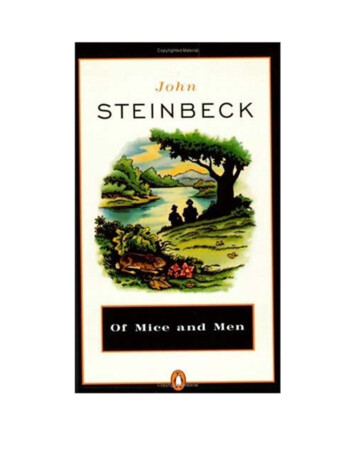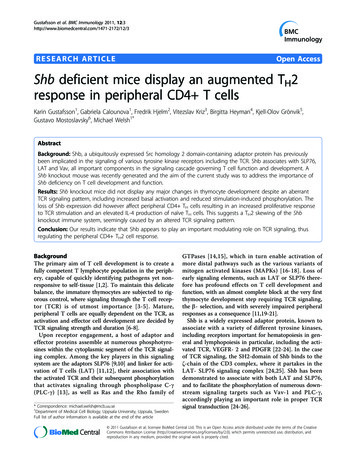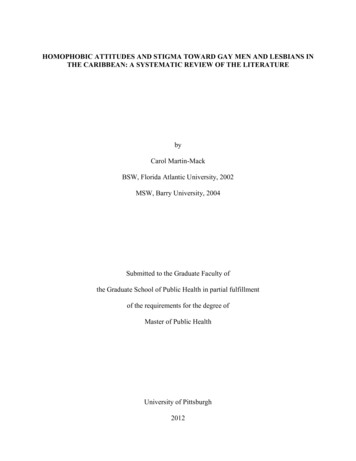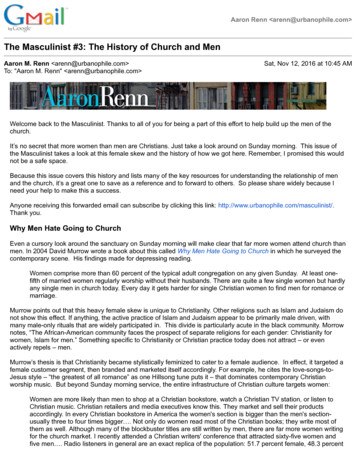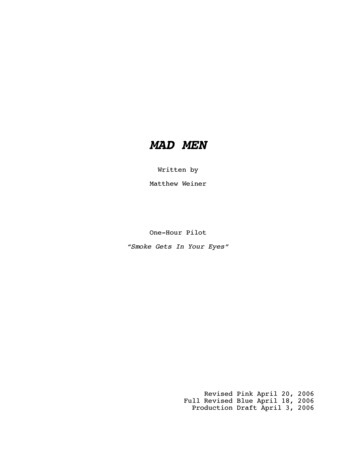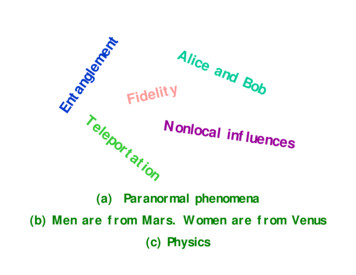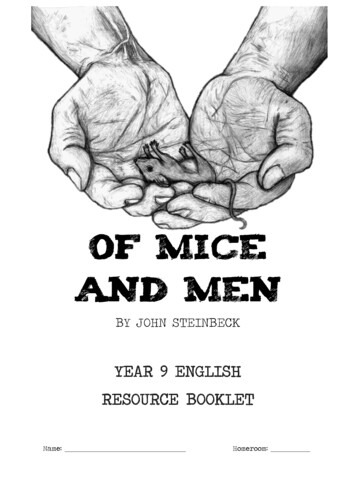
Transcription
OF MICEAND MENBY JOHN STEINBECKYEAR 9 ENGLISHRESOURCE BOOKLETName:Homeroom:
2
‘Of Mice and Men’ Resource Guide ContentsUnit Overview . 3INTRODUCTORY MATERIALS‘Us Two’ . 7‘To a Mouse’ . 8The World of 1937. 10Background: The American Dream . 11Background: The Great Depression . 12Background: The Dust Bowl. 13Images of the Dust Bowl. 15Background: The Novel . 19CHAPTER QUESTIONS AND ACTIVITIESChapter One Questions . 23Chapter Two Questions . 24Chapter Three Questions . 25Chapter Four Questions . 26Chapter Five Questions . 27Chapter Six Questions . 28George and Lennie: Setting the Scene . 29Dreams . 30“Livin’ off the fatta the lan’!” . 35Character Facebook Profiles . 37Curley’s Wife . 43The Marginalised . 45Foreshadowing . 46Courtroom Drama . 51Write Like Steinbeck . 54Figurative Language in of Mice and Men . 55GLOSSARIESColloquialisms . 59Novel Vocabulary . 60Essay Vocabulary . 62Transition Words . 63ESSAY MATERIALSText Response Essay overview . 67Sample Topic: The importance of dreams . 69Sample Topic: Isolation and loneliness . 72Sample Topic: Characters feeling trapped. 74Sample Topic: The American Dream . 75Sample Essay Topics . 76SUMMARIES AND ANALYSISCharacters Mind Map . 79Timeline of Events . 80Chapter Summaries . 81Chapter Analysis . 89Theme Analysis. 95Key Quotes . 99LitChart . 105
List of SourcesAny materials that are not original works by St Leonard’s staff were sourced from the following websites:-Curve Learn (englishtutorhome2.blogspot.com)Digital History (www.digitalhistory.uh.edu)The Hypertexts (www.thehypertexts.com)Library of Congress (www.loc.gov)Litcharts (www.litcharts.com)Sparknotes (www.sparknotes.com)TES Connect (www.tes.co.uk)United States History (www.u-s-history.com)University of NSW (student.unsw.edu.au)2
Year 9 English: ‘Of Mice and Men’unit overviewOverarching Question: Do we all need a dream and a friend to share it with?Essential Questions: What is meant by the American Dream?Is the American dream a destructive or empowering force?What leads a person to become isolated in a community?Can social disadvantage be overcome?How much control does an individual have over their destiny?What is the value of loyalty in friendship?Can you be cruel to be kind?Assessment: Text Response Essay: 80 minute in-class test (Term 2 Week 2)Text Response Essay: Mid-Year Exam (Term 2 Week 8)3
4
INTRODUCTORYMATERALS5
6
‘Us Two’Poem by A.A. MilneWherever I am, there's always Pooh,There's always Pooh and Me.Whatever I do, he wants to do,"Where are you going today?" says Pooh:"Well, that's very odd 'cos I was too.Let's go together," says Pooh, says he."Let's go together," says Pooh."What's twice eleven?" I said to Pooh.Using the poem ‘Us Two’ asinspiration, answer the followingquestions. Use examples, from thepoem if possible, in order toillustrate your responses:1. What exactly is ‘friendship’?2. What will determinewhether or not a person isa ‘friend’?3. Why is friendshipimportant?4. What can a strongfriendship allow us to do?("Twice what?" said Pooh to Me.)"I think it ought to be twenty-two.""Just what I think myself," said Pooh."It wasn't an easy sum to do,But that's what it is," said Pooh, said he."That's what it is," said Pooh."Let's look for dragons," I said to Pooh."Yes, let's," said Pooh to Me.We crossed the river and found a few"Yes, those are dragons all right," said Pooh."As soon as I saw their beaks I knew.That's what they are," said Pooh, said he."That's what they are," said Pooh."Let's frighten the dragons," I said to Pooh."That's right," said Pooh to Me."I'm not afraid," I said to Pooh,And I held his paw and I shouted "Shoo!Silly old dragons!"- and off they flew."I wasn't afraid," said Pooh, said he,"I'm never afraid with you."So wherever I am, there's always Pooh,There's always Pooh and Me."What would I do?" I said to Pooh,"If it wasn't for you," and Pooh said: "True,It isn't much fun for One, but Two,Can stick together, says Pooh, says he. "That's how it is," says Pooh.7
‘To a Mouse’Original poem by Robert BurnsModern translation by Michael BurchORIGINAL TEXTMODERN TRANSLATIONWee, sleeket, cowran, tim'rous beastie,O, what panic's in thy breastie!Thou need na start awa sae hasty,Wi' bickering brattle!I wad be laith to rin an' chase thee,Wi' murd'ring pattle!Sleek, tiny, timorous, cowering beast,why's such panic in your breast?Why dash away, so quick, so rash,in a frenzied flashwhen I would be loath to run after youwith a murderous plowstaff!I'm truly sorry Man's dominionHas broken Nature's social union,An' justifies that ill opinion,Which makes thee startle,At me, thy poor, earth-born companion,An' fellow-mortal!I'm truly sorry Man's dominionhas broken Nature's social union,and justifies that bad opinionwhich makes you startle,when I'm your poor, earth-born companionand fellow mortal!I doubt na, whyles, but thou may thieve;What then? poor beastie, thou maun live!A daimen-icker in a thrave'S a sma' request:I'll get a blessin wi' the lave,An' never miss't!I have no doubt you sometimes thieve;What of it, friend? You too must live!A random corn-ear in a shock'sa small behest; it'll give me a blessing to know such a loss;I'll never miss it!Thy wee-bit housie, too, in ruin!It's silly wa's the win's are strewin!An' naething, now, to big a new ane,O' foggage green!An' bleak December's winds ensuin,Baith snell an' keen!Your tiny house lies in a ruin,its fragile walls wind-rent and strewn!Now nothing's left to construct you a new oneof mosses greensince bleak December's winds, ensuing,blow fast and keen!Thou saw the fields laid bare an' wast,An' weary Winter comin fast,An' cozie here, beneath the blast,Thou thought to dwell,Till crash! the cruel coulter pastOut thro' thy cell.You saw your fields laid bare and wastewith weary winter closing fast,and cozy here, beneath the blast,you thought to dwell,till crash! the cruel iron ploughshare passedstraight through your cell!That wee-bit heap o' leaves an' stibble,Has cost thee monie a weary nibble!Now thou's turn'd out, for a' thy trouble,But house or hald.To thole the Winter's sleety dribble,An' cranreuch cauld!That flimsy heap of leaves and stubblehad cost you many a weary nibble!Now you're turned out, for all your trouble,less house and hold,to endure cold winter's icy dribbleand hoarfrosts cold!8
But Mousie, thou are no thy-lane,In proving foresight may be vain:The best laid schemes o' Mice an' Men,Gang aft agley,An' lea'e us nought but grief an' pain,For promis'd joy!But mouse-friend, you are not alonein proving foresight may be vain:the best-laid schemes of Mice and Mengo oft awry,and leave us only grief and pain,for promised joy!Still, thou art blest, compar'd wi' me!The present only toucheth thee:But Och! I backward cast my e'e,On prospects drear!An' forward, tho' I canna see,I guess an' fear!Still, friend, you're blessed compared with me!Only present dangers make you flee:But, ouch!, behind me I can seegrim prospects drear!While forward-looking seers, wehumans guess and fear!The title of Steinbeck’s novel comes from a poem by the 18th centuryScottish poet Robbie Burns, which is written in an old Scottish dialect. Itis about a mouse which carefully builds a winter nest in a wheat field,only for it to be destroyed by a ploughman. The mouse had dreamed of asafe, warm winter and is now faced with the harsh reality of cold,loneliness and possible death. There is a parallel here with George andLennie's joyful fantasy of a farm of their own, and its all-too-predictabledestruction at the end of the story. The two main themes in Of Mice andMen – foreshadowed by the reference to Burns' mouse – are lonelinessand dreams. These two themes interlock: people who are lonely have mostneed of dreams to help them through.9
The World of 1937Use the information on the following pages to answer the questions below. If you find thatyou need to undertake additional research in order to answer the questions fully, make sureyou select your search terms carefully in order to narrow the scope of your search results.The American Dream1. What is the ‘American Dream’?2. Why is the American Dream so attractive?3. Is the American Dream truly ‘attainable’ by all people?The Great Depression1. What was the Great Depression?2. What effect did the Great Depression have on the lives ofordinary Americans?3. How did the Great Depression change American society?The Dust Bowl1. What was the Dust Bowl?2. What effect did the Dust Bowl have on the lives of farmers?3. How did the events of Great Depression and the Dust Bowlchallenge the concept of the American Dream?10
Background: The American DreamWhat is the American Dream?James Truslow Adams, in his book The Epic of America, which was written in 1931, stated that theAmerican dream is "that dream of a land in which life should be better and richer and fuller foreveryone, with opportunity for each according to ability or achievement. It is a difficult dream forthe European upper classes to interpret adequately, and too many of us ourselves have grown wearyand mistrustful of it. It is not a dream of motor cars and high wages merely, but a dream of socialorder in which each man and each woman shall be able to attain to the fullest stature of which theyare innately capable, and be recognized by others for what they are, regardless of the fortuitouscircumstances of birth or position." (p.214-215)The authors of the United States’ Declaration of Independence held certain truths to be self-evident:“that all Men are created equal, that they are endowed by their Creator with certain unalienableRights, that among these are life, Liberty and the Pursuit of Happiness." Might this sentiment beconsidered the foundation of the American Dream?Were homesteaders who left the big cities of the east to find happiness and their piece of land in theunknown wilderness pursuing these inalienable Rights? Were the immigrants who came to theUnited States looking for their bit of life, liberty and the pursuit of happiness, their Dream? And whatdid the desire of the veteran of World War II - to settle down, to have a home, a car and a family tell us about this evolving Dream? Is the American Dream attainable by all Americans?Some say, that the American Dream has become the pursuit of material prosperity - that peoplework more hours to get bigger cars, fancier homes, the fruits of prosperity for their families - buthave less time to enjoy their prosperity. Others say that the American Dream is beyond the grasp ofthe working poor who must work two jobs to insure their family’s survival. Yet others look toward anew American Dream with less focus on financial gain and more emphasis on living a simple,fulfilling life.Thomas Wolfe said, " to every man, regardless of his birth, his shining, golden opportunity .theright to live, to work, to be himself, and to become whatever thing his manhood and his vision cancombine to make him."Source: Library of Congress11
Background: The Great DepressionOn October 4 1929, millions of dollars were wiped out in an event that became known as the WallStreet Crash. It led to the Depression in America which crippled the country from 1930 - 1936.People lost their life savings when firms and banks went bust, and 12 - 15 million men and women one third of America's population - were unemployed.OVERVIEW OF THE GREAT DEPRESSIONThe Great Depression was steeper and more protracted in the United States than in otherindustrialized countries. The unemployment rate rose higher and remained higher longer than in anyother western country. As it deepened, the Depression had far-reaching political consequences. TheDepression vastly expanded the scope and scale of the federal government and created the modernwelfare state. It gave rise to a philosophy that the federal government should provide a safety netfor the elderly, the jobless, the disabled, and the poor, and that the federal government wasresponsible for ensuring the health of the nation's economy and the welfare of its citizens.The stock market crash of October 1929 brought the economic prosperity of the 1920s to a symbolicend. For the next ten years, the United States was mired in a deep economic depression. By 1933,unemployment had soared to 25 percent, up from 3.2 percent in 1929. Industrial productiondeclined by 50 percent, international trade plunged 30 percent, and investment fell 98 percent.CAUSES OF THE DEPRESSIONCauses of the Great Depression included: insufficient purchasing power among the middle class andthe working class to sustain high levels of production; falling crop and commodity prices prior to theDepression; the stock market's dependence on borrowed money; and wrongheaded governmentpolicies, including high tariffs that reduced international trade and contracted the money supply.POLITICAL AND SOCIAL CONSEQUENCESThe Great Depression transformed the American political and economic landscape. It produced amajor political realignment. It strengthened the government’s presence in American life, spawningsuch innovations as national old-age pensions, unemployment compensation, aid to dependentchildren, public housing, federally-subsidized school lunches, the minimum wage, and stock marketregulation. It fundamentally altered labour relations, producing a revived union movement and anational labour policy protective of collective bargaining. It transformed the farm economy byintroducing federal subsidies. Above all, it led Americans to view the federal government as anagency of action and reform and the ultimate protector of public well-being.THE GREAT DEPRESSION AND AMERICAN CULTUREThe Great Depression challenged certain basic precepts of American culture, especially the faith inindividual self-help, business, the inevitability of progress, and limited government. The Depressionencouraged a search for the real America.Source: Digital History12
Background: The Dust BowlA PROMISED LANDWhen pioneers began to migrate across the country in the middle of the 19th century, they were insearch of ideal farmland. What they saw, in the vast expanse of prairie in the Midwest, was apromised land. The grass that covered the plains stood six feet high and stretched all the way fromCanada south to Texas. Homesteaders flocked to the grasslands, certain that they had found therichest soil in the world and the ideal place to settle down. Men began to clear the land — using theendless prairie to grow wheat, and the trees to build houses, barns and outbuildings.What was unknown to these early pioneers was that the grass and trees of the plains essentiallynourished and held the soil in place with their tough roots. When they were gone, the moisture thatwould have gone to the roots ran off into creeks, streams and rivers — basically carrying the landwith it. The scene was set for the Dust Bowl.In 1930, there was no better place to be a farmer than in the Southern Plains, where men andwomen had turned untamed prairie into one of the most prosperous regions in the whole country.The rest of the nation was struggling with the initial effects of the Great Depression, but in wheatcountry, farmers were reaping a record-breaking crop.With the onset of World War I, the demand for wheat had been astonishing. Farmers were paidrecord prices. Thus, to the farmer, it made sense to turn every inch of the Southern Plains into profit.During the war, the land produced millions and millions of bushels of wheat and corn, which helpedto feed America as well as numerous nations overseas.The farming practices that made the plains so productive were beginning to take a toll on the land.The grasslands had been deeply ploughed and planted. During the years when there was adequaterainfall, the land produced bountiful crops. However, as a drought that started in the early 1930spersisted, the farmers kept ploughing and planting with increasingly dismal results.In 1930 and early 1931, the Oklahoma and Texas panhandles were known as the most prosperousregions in the nation. For plains farmers, the decade opened with prosperity and growth. But in thesummer of 1931, those farmers would face the most difficult eight years of their lives. The rainsimply stopped.CAUSE AND EFFECTIt had taken a thousand years for Nature to build an inch of topsoil on the Southern Plains, but ittook only minutes for one good blow to sweep it all away. The water level of lakes dropped by fivefeet or more. The wind picked up the dry soil that had nothing to hold it down. Great black clouds ofdust began to blot out the sun. In some places, the dust drifted like snow, darkening the sky for days,covering even well-sealed homes with a thick layer of dust on everything. Dust storms engulfedentire towns.The primary impact area of the Dust Bowl, as it came to be known, was on the Southern Plains. TheNorthern Plains weren t so badly affected, but the drought, dust, and agricultural decline were feltthere as well. The agricultural devastation helped to lengthen the Great Depression, whose effectswere felt worldwide.13
One hundred million acres of the Southern Plains were turning into a wasteland of the Dust Bowl.Large sections of five states were affected — Texas, Oklahoma, Kansas, Colorado and New Mexico.In 1932, the national weather bureau reported 14 dust storms. The next year, they were up to 38.The dust was so thick that people scooped up bucketsful while cleaning house. Dust blocked exteriordoors; to get outside, people had to climb out their windows and shovel the dust away. Dust coatedeverything.Nevertheless, farmers kept on ploughing, hopeful that the rains would return in a matter of days, orperhaps months. In the spring of 1934, the massive drought impacted 27 states severely andaffected more than 75 percent of the country. The Dust Bowl was result of the worst drought in U.S.history.A MEAGRE EXISTENCEFamilies survived on cornbread, beans, and milk. People were beginning to give up hope, and a massexodus — the largest migration in American history — ensued from the plains. Many families packedtheir belongings, piled them on their cars and moved westward, fleeing the dust and desert of theMidwest for Washington, Oregon and California. They were willing to work for any wage at all,planting and harvesting other people s lands.When those families reached the borders of those western states, they were not well received —too many people already there were out of work. Many California farms were corporate owned,meaning they were larger and more modernized than what the farmers were used to. Families oftenlived in tar-paper shacks with no floor or plumbing. By 1940, 2.5 million people had moved out ofthe Dust Bowl states toward the Pacific states.In the fall of 1934, with cattle feed depleted, the government began to buy and destroy thousands ofstarving livestock. Of all the government programs during that time, the cattle slaughter was themost wrenching for farmers. Although it was difficult for farmers to give up their herds, the cattleslaughter helped many of them avoid bankruptcy.In the spring of 1935, the wind blew 27 days and nights without stopping. People and animals beganto die of suffocation and "dust pneumonia."SOIL CONSERVATIONIn 1937, the federal government began an aggressive campaign to encourage Dust Bowlers to adoptplanting and ploughing methods that conserve the soil. The government paid the reluctant farmers adollar an acre to practice one of the new methods. By 1938, the massive conservation effort hadreduced the amount of blowing soil by 65 percent. Nevertheless, the land failed to yield a decentliving.In the fall of 1939, after nearly a decade of dirt and dust, the skies finally opened. With the rain sreturn, dry fields soon yielded their golden wheat once more, and just as quickly as it had begun, theDust Bowl was, thankfully, over.Source: http://www.u-s-history.com/pages/h1583.html14
Images of the Dust BowlA farmer shows how high thewheat should be.North Dakota, July 1936.Source: PBSDust storm approaching town.Texas, 1935.Source: Wikimedia CommonsA gigantic dust cloud looms overa ranch in Boise City.Oklahoma, April 1935.Source: National Geographic15
Abandoned farm and windmill.Texas, June 1938.Source: PBSMigrant man looking up atbillboard.Iowa, April 1940.Source: PBSA migrant family on the road.Oklahoma, June 1938.Source: PBS16
Two migrant workers travellingalong the highway toward LosAngeles passing a billboard forthe train. Perhaps 2.5 millionpeople abandoned their homesin the South and the Great Plainsduring the Great Depression andwent on the road.California, 1935.Source: Library of CongressFlorence Thompson and herchildren.California, March 1936.Source: PBSMigrant families camp by theside of the road near Calipatria,California.California, March 1937.Source: Library of Congress17
Migrant workers' camp,outskirts of Marysville,California. Eventually newmigratory camps are built by theResettlement Administration inorder to remove people fromunsatisfactory living conditionssuch as these and establish atleast minimum sanitation.Source: The History PlaceNear Meloland, Imperial Valley,California. Large scaleagriculture using gang labour.Pull, clean, tie and crate carrotsfor the eastern market foreleven cents per crate of fortyeight bunches. Many can makebarely one dollar a day. Heavyoversupply of labour andcompetition for jobs meanswages remain low.Source: The History PlaceSquatter makes coffee in kitchenof the home he has made in anabandoned warehouse inCaruthersville.Missouri, August 1938.Source: Library of Congress18
Background: The NovelAUTHOR BIOGRAPHYJohn Steinbeck (1902-1968) was born in Salinas, California. He came from a middle class family. Hisfather was the county treasurer, and his mother was a former schoolteacher. She inspired andencouraged his love of books and reading.He attended Stanford University, but he did not graduate. In his twenties, he travelled to New YorkCity with the dream of supporting himself as a freelance writer. When his efforts failed, he wenthome to California. He then began to work seriously on novels and short stories.When Steinbeck was a young adult, he spent his summer vacations working as a hired hand on localranches. His interactions with the people he met during those summers greatly influenced thecharacters he created throughout his career. In an interview following the publication of Of Miceand Men, Steinbeck revealed that all the characters in the novel are composites based on realpeople.Steinbeck said in his essay “Advice For Beginning Writers” (1963) that he still felt afraid every timehe began writing a story, even though he had a long successful writing career behind him. He wenton to say that a writer who does not experience this fear may not have an appropriate respect forthe art of writing.NOVEL BACKGROUNDOf Mice and Men was published in 1937, after John Steinbeck had achieved literary acclaim with hisnovel Tortilla Flat but before he wrote his better known works The Grapes of Wrath and East ofEden. The story epitomizes the themes and ideas that Steinbeck propounded throughout his novels:the plight of the labourers, the perils of isolation, and the hope for a better future. Set in Californiaduring the Great Depression, Of Mice and Men is an excellent vehicle to learn about the life andtimes of migrant works in the 1930s. With its beautiful descriptive passages, easily accessibledialogue, and fast-paced timeline, it is very easy to follow along. Readers are drawn in by thememorable characters that, ironically, represent a segment of society that was largely ignored in itsday. Analysing the balance of power, the importance of friendship, and the role of dreams in ourlives allows readers to gain a deeper understanding of the text while applying valuable lessons totheir own lives.NOVEL SETTINGOf Mice and Men is set in the Salinas Valley of Southern California in the late 1930’s, the era of theGreat Depression. Like many writers of the Modern Period (1915-1945), John Steinbeck attempts tomake sense of the early decades of the 20th century; he sees the humanity in a class of people whoare often ignored by writers and by society at large. These issues are further developed inSteinbeck’s The Grapes of Wrath.19
CHARACTER LISTBelow is a list of the major characters from Of Mice and Men: Lennie Small: a nondescript, hulking creature of a man whose childlike mentality continuallygets him into scrapes with men who neither respect nor understand him.George Milton: a small, lean man, used to fighting for his place in the world. He overseesand protects Lennie.Slim: a tall skinner (a highly skilled mule-driver) that serves as a counsellor to the ranchhands.Candy: The one-handed ranch worker who has lived past his prime.Curley’s wife: never named, she is not respected by the men on the ranch.Crooks: the African-Ameri
American dream is "that dream of a land in which life should be better and richer and fuller for everyone, with opportunity for each according to ability or achievement. It is a difficult dream for the European
